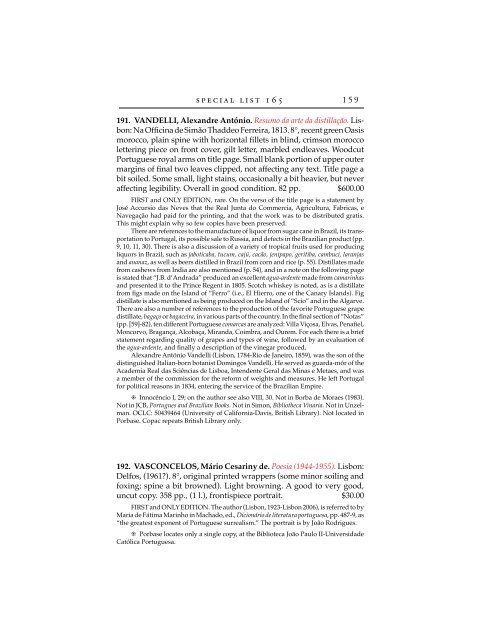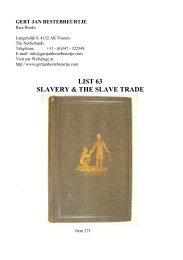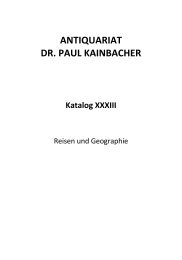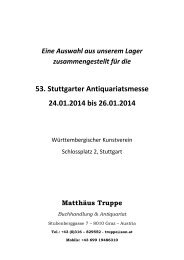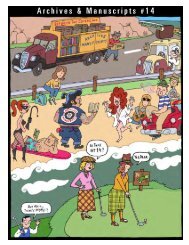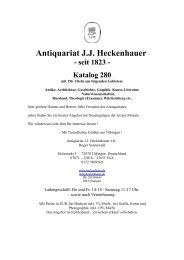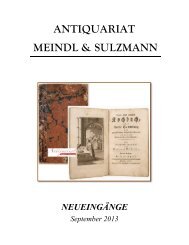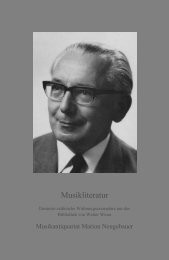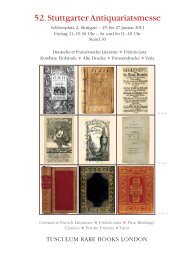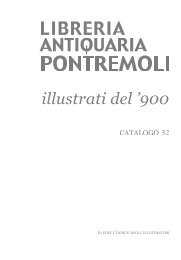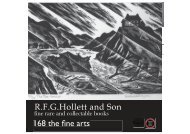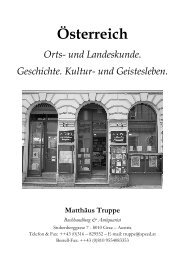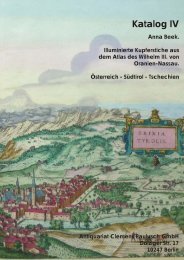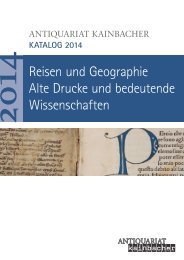Recent Acquisitions - Richard C. Ramer Old & Rare Books
Recent Acquisitions - Richard C. Ramer Old & Rare Books
Recent Acquisitions - Richard C. Ramer Old & Rare Books
Create successful ePaper yourself
Turn your PDF publications into a flip-book with our unique Google optimized e-Paper software.
special list 165 159<br />
191. VANDELLI, Alexandre António. Resumo da arte da distillação. Lisbon:<br />
Na Officina de Simão Thaddeo Ferreira, 1813. 8°, recent green Oasis<br />
morocco, plain spine with horizontal fillets in blind, crimson morocco<br />
lettering piece on front cover, gilt letter, marbled endleaves. Woodcut<br />
Portuguese royal arms on title page. Small blank portion of upper outer<br />
margins of final two leaves clipped, not affecting any text. Title page a<br />
bit soiled. Some small, light stains, occasionally a bit heavier, but never<br />
affecting legibility. Overall in good condition. 82 pp. $600.00<br />
FIRST and ONLY EDITION, rare. On the verso of the title page is a statement by<br />
José Accursio das Neves that the Real Junta do Commercia, Agricultura, Fabricas, e<br />
Navegação had paid for the printing, and that the work was to be distributed gratis.<br />
This might explain why so few copies have been preserved.<br />
There are references to the manufacture of liquor from sugar cane in Brazil, its transportation<br />
to Portugal, its possible sale to Russia, and defects in the Brazilian product (pp.<br />
9, 10, 11, 30). There is also a discussion of a variety of tropical fruits used for producing<br />
liquors in Brazil, such as jaboticaba, tucum, cajú, cacão, jenipapo, geritiba, cambuci, laranjas<br />
and ananaz, as well as beers distilled in Brazil from corn and rice (p. 55). Distillates made<br />
from cashews from India are also mentioned (p. 54), and in a note on the following page<br />
is stated that “J.B. d’Andrada” produced an excellent agua-ardente made from camarinhas<br />
and presented it to the Prince Regent in 1805. Scotch whiskey is noted, as is a distillate<br />
from figs made on the Island of “Ferro” (i.e., El Hierro, one of the Canary Islands). Fig<br />
distillate is also mentioned as being produced on the Island of “Scio” and in the Algarve.<br />
There are also a number of references to the production of the favorite Portuguese grape<br />
distillate, bagaço or bagaceira, in various parts of the country. In the final section of “Notas”<br />
(pp. [59]-82), ten different Portuguese comarcas are analyzed: Villa Viçosa, Elvas, Penafiel,<br />
Moncorvo, Bragança, Alcobaça, Miranda, Coimbra, and Ourem. For each there is a brief<br />
statement regarding quality of grapes and types of wine, followed by an evaluation of<br />
the agua-ardente, and finally a description of the vinegar produced.<br />
Alexandre António Vandelli (Lisbon, 1784-Rio de Janeiro, 1859), was the son of the<br />
distinguished Italian-born botanist Domingos Vandelli. He served as guarda-mór of the<br />
Academia Real das Sciências de Lisboa, Intendente Geral das Minas e Metaes, and was<br />
a member of the commission for the reform of weights and measures. He left Portugal<br />
for political reasons in 1834, entering the service of the Brazilian Empire.<br />
j Innocêncio I, 29; on the author see also VIII, 30. Not in Borba de Moraes (1983).<br />
Not in JCB, Portugues and Brazilian <strong>Books</strong>. Not in Simon, Bibliotheca Vinaria. Not in Unzelman.<br />
OCLC: 50439464 (University of California-Davis, British Library). Not located in<br />
Porbase. Copac repeats British Library only.<br />
192. VASCONCELOS, Mário Cesariny de. Poesia (1944-1955). Lisbon:<br />
Delfos, (1961?). 8°, original printed wrappers (some minor soiling and<br />
foxing; spine a bit browned). Light browning. A good to very good,<br />
uncut copy. 358 pp., (1 l.), frontispiece portrait. $30.00<br />
FIRST and ONLY EDITION. The author (Lisbon, 1923-Lisbon 2006), is referred to by<br />
Maria de Fátima Marinho in Machado, ed., Dicionário de literatura portuguesa, pp. 487-9, as<br />
“the greatest exponent of Portuguese surrealism.” The portrait is by João Rodrigues.<br />
j Porbase locates only a single copy, at the Biblioteca João Paulo II-Universidade<br />
Católica Portuguesa.


